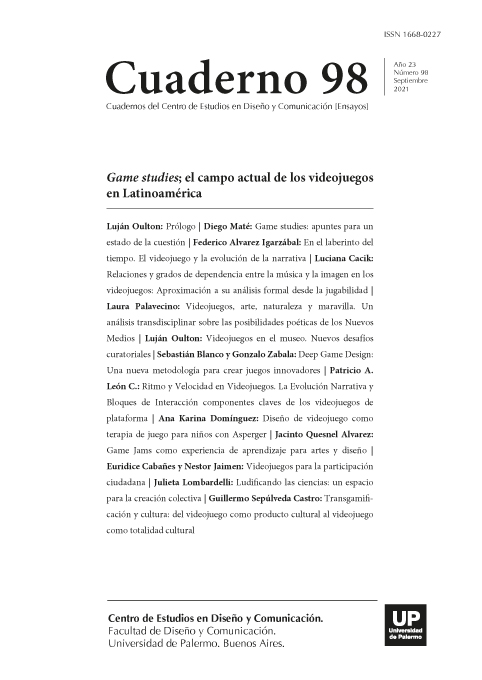Diseño de videojuego como terapia de juego para niños con Asperger
Abstract
In the last decade, information and communication technologies (ICT) have been adapted to meet the needs of people with disabilities, allowing them to reach their full potential. In this sense, videogames, which previously alluded only to leisure, have become one of the technological tools applied to the educational and therapeutic field, understanding that in order to personalize the teaching method, skills, needs and learning styles must be taken into account of all the users. Today there is a portion of the population, known as Autism Spectrum Disorder (ASD), which presents special educational needs, and who can work with cognitive and social skills through the use of adapted technology
References
Altanis, G., Boloudakis, M., Retalis, S. y Nikoy, N. (2013). “Children with Motor Impairments Play a Kinect Learning Game: First Findings from a Pilot Case in an Authentic Classroom Environment”. Interaction Design and Architecture (IxD&A)
Attwood, T. (1998). Asperger’s syndrome. London: Jessica Kingsley
Bernard-Opitz, V., Sriram, N. y Nakhoda-Sapuan. (2001). “Enhancing social problem solving in children with autism and normal children through computer-assisted instruction”. Journal of Autism and Developmental Disorders, 31(4), 377-384.
Bölte S , Feineis-Matthews S , Leber S , Dierks T , Hubl D , Poustka F . (2002). “The development and evaluation of a computer-based program to test and to teach the recognition of facial affect”. International Journal of Circumpolar Health, 61 (Suppl. 2), 61-68. Recopilado de https://www.ncbi.nlm.nih.gov/pubmed/12585821
Chaloner, W. (2001). Counselors coaching teachers to use play therapy in classrooms: The Play and Language to Succeed early, school-based intervention for behaviorally at-risk children.
Cook, A. y, Polgar, J., (2015), Assistive Technologies: Principles & Practices, Dealessandri, M. (2018). Hellblade: Senua’s Sacrifice at forefront of BAFTA Games Awards nominations. United Kindgdom: MCV.
Del Moral, M. y Villalustre, L. (2010). Consumo televisivo y de videojuegos de los escolares asturianos versus desarrollo de competencias audiovisuales y digitales. En Del Moral (coord.). Televisión: desarrollo de la creatividad e infancia. (31-46). Barcelona: Editorial Octaedro.
Demarest, G. (2000). Video games-What are they good for? Recuperado el 25 de abril de 2007 de http://www.lessontutor.com/kd3.html.
Esnaola, G. (2011). Hacia una pedagogía lúdica incidental. San Martín y Peirats (Eds.). Tecnologías Educativas 2.0. Didáctica de los contenidos digitales. Madrid, Pearson.
Freitas, F, (2008): “Emerging trends in serious games and virtual words”. En Emer-ging Technologies for learning. Vol. 3
García, E. y Jorreto, R. (2005) Sindrome de Asperger: Un enfoque multidisciplinar. Actas de la 1ª Jornada Cientìfico-Sanitaria sobre Sìndrome de Asperger. Sevilla. Recuperado de http://asperger.org.ar/wp-content/uploads/2015/12/Sindrome-de-Asperger-un-enfoqueMultidisciplinario.pdf .
González, J. (2010). Caracterización de la Experiencia del Jugador en Videojuegos (Doctorado). Universidad de Granada. Recuperado de https://hera.ugr.es/tesisugr/18931200.pdf
Gros, B. (2008). “La dimensión socioeducativa de los videojuegos, Edutec”. Revista Electrónica de Tecnología Educativa, nº 12.
Hafer, T. (2017). LEGO Worlds Review. California: IGN. Recuperado de: http://www.ign.com/articles/2017/03/16/lego-worlds-review.
Hardy, C., Ogden, J., Newman, J. & Cooper, S. (2002). Autism and ICT: A guide for teachers and parents. London: David Fulton.
Haworth, M. (1964). Child psychotherapy: Practice and theory.
Howlin P. & Moore A., (1997). Diagnoisis in Autism: A Surver of Over 1200 Patients in the UK.
Tortosa, F. (2004). Tecnologías de Ayuda en Personas con Trastorno Autista: Guía para Docentes. Murcia: CPR Murcia I.
Klawe, M. (1994) The educational potential of electronic games and the E-GEMS project. En T. Ottam, I. Tomek (Eds). Proc of ED-MEDIA 94: World Conference on Educational Multimedia and Hypermedia. Charlottesville, VA: AACE.
Lavie, T. and Tractinsky, N. (2004). Assessing dimensions of perceived visual aesthetics of web sites. International Journal of Human-Computer Studies, 60, 269-298.
Lazzaro N. (2008) 4 Fun Keys: Testing Emotions and Player Experiences. In Game Usability: Advice from the Experts for Advancing the Player Experience. Morgan Kaufmann, San Francisco, CA
Lehman, J. (1998). A featured based comparison of software preferences in typically-developing children versus children with autism spectrum disorders. Recuperado el 03 de octubre de 2008 de http://www.cs.cmu.edu/People/jef/survey.html.
Marcos, M. (1987). “La actividad lúdica en la edad preescolar: su influencia en l educación cognitiva”. Universidad Pontificia de Salamanca.
Martz, L. (2005). Free Time! Ludicity and the Anti-Work Ethic.
Moore, D., Cheng, Y., McGrath, P. & Powell, N. (2005). Collaborative virtual environment technology for people with autism. Focus on Autism and Other Developmental Disabilities, 20(4), 231-243. Nielsen Norman Group (1993). Heuristic evaluation. Ed. Nielsen, J., and Mack, R.L.: Usability Inspection. Recuperado de https://www.nngroup.com/search/?q=Heuristic+evaluation
Norman D. (2002) The design of everyday things. Nueva York: Basic Books.Recuperado de https://www.nngroup.com/books/the-design-of-everyday-things/
Sedighian, K. (1996) “Can Educational Computer Games Help Educators Learn About the Psychology of Learning Mathematics in Children?”. 18th Annual Meeting of the International Group for the Psychology of Mathematics Education.
Paniagua, A. (2016) Lego terapia: Desarrollo social de niños con TEA. Informe publicado en Diario el Cisne. Fundaciòn Centro Crianza.
Parsons, S., Leonard, A. y MitchelL, C. (2006). “Virtual Environments for social Skills Training: Comments from Two Adolescents with Autistic Spectrum Disorder.” Computers & Education, 47(2), 186-206.
Passerino, L. M. y Santarosa, L. C. (2008). “Autism and digital learning environments: Processes of interaction and mediation.” Computer & Education, 51, 385-402.
Phillips, T. (2017). Lego Marvel Super Heroes 2 announced. Eurogamer.
Ramsay, R. (2017). Lego Marvel Super Heroes 2 Review. Gamespot.
Usability-First (2009). Usability First. Recuperado el 2018, de Playability Definition: Recuperado de http//www.usabilityfirst.com/glossary/playability
Volkmar, F. R., & Klin, A. (2000). Diagnostic issues in Asperger syndrome. Asperger syndrome (pp. 25-71). New York, NY, US: The Guilford Press.
Vygotsky, L.S. (1977) Thought and Language. Cambridge. Mass: MIT Press, 1932 (Trad. Pensamiento y lenguaje. Buenos Aires. La Pléyade
Yuan, B., Folmer, E. & Frederick, H. Jr. (2010). “Game Accessibility: a survey.” Universal Access in the Information Society. 10, pp.1- 10.
Los autores/as que publiquen en esta revista ceden los derechos de autor y de publicación a "Cuadernos del Centro de Estudios de Diseño y Comunicación", Aceptando el registro de su trabajo bajo una licencia de atribución de Creative Commons, que permite a terceros utilizar lo publicado siempre que de el crédito pertinente a los autores y a esta revista.


